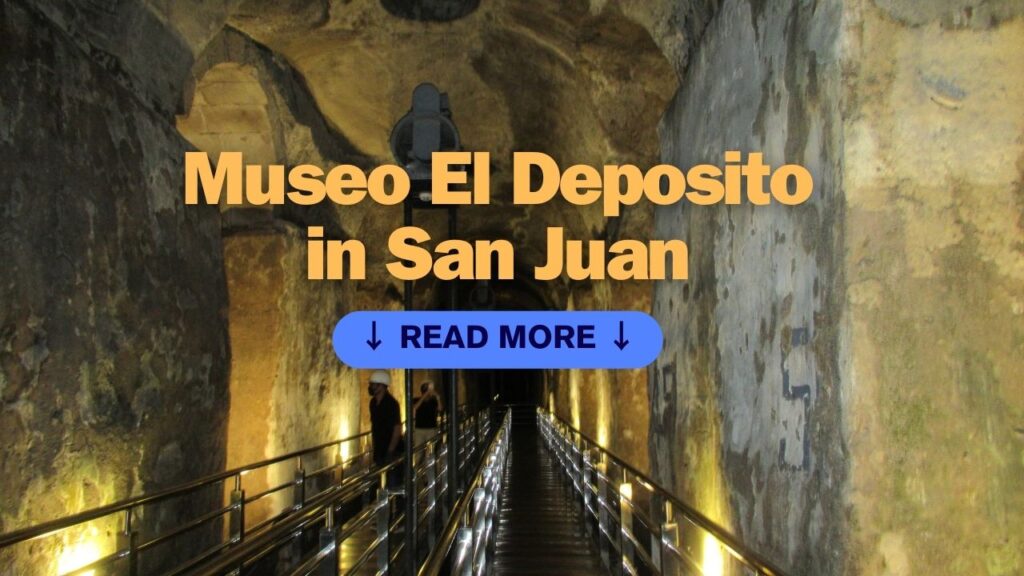Discover the Wonders of Museo El Deposito in San Juan, Metro Manila
9 min read
Museo El Deposito: A Comprehensive Guide to San Juan City’s Iconic Museum
Museo El Deposito is a history museum located in San Juan, Metro Manila, Philippines. The museum is situated within the grounds of Pinaglabanan Shrine and features the Carriedo water system, including the El Deposito underwater reservoir. The museum opened its doors to the public in 2019 and has since been a popular destination for locals and tourists alike.
Visitors can explore the museum’s three galleries, which include an audio-visual room, a resource center, and a virtual reality room. The ground floor of the museum houses an AVR that projects a short video clip on the history and the construction of the waterwork system in the site. The museum is open from Tuesday to Sunday, 9 a.m. to 4 p.m. and entrance is free.
Museo El Deposito provides a unique opportunity to learn about the history and significance of the Carriedo water system, which provided water to Manila’s fountains and hydrants. The museum’s collection of artifacts and exhibits offer an immersive experience that highlights the importance of the water system to the development of the city. Anyone interested in learning more about the history of San Juan and Manila should definitely add Museo El Deposito to their list of must-visit destinations.
History and Significance

Founding of El Deposito
Museo El Deposito features the Carriedo Waterworks System, which includes the El Deposito underwater reservoir. The museum opened on February 20, 2019, and is situated within the grounds of the Pinaglabanan Shrine. The museum contains many artifacts related to the reservoir’s history, including replicas of the Carriedo fountain, an original Spanish-era water hydrant, and 19th-century water filtration systems.

The El Deposito was constructed in 1882 during the Spanish Era to provide water to Manila. It was part of the Carriedo Waterworks System, named after Francisco Carriedo, the man who made his fortune on the galleon trade and donated P10,000 to Manila in 1783. The system was designed to provide water to the city’s residents and fight fires common in the city at the time.
Role in the Philippine Revolution
During the Philippine Revolution, the Carriedo Waterworks System and El Deposito played a significant role in the Battle of San Juan del Monte. The revolutionaries, led by Genaro Palacios, attacked the Spanish forces stationed at El Deposito on August 30, 1896. The battle resulted in a victory for the revolutionaries and is considered one of the first major battles of the revolution.
Carriedo Legacy and Waterworks
The Carriedo Waterworks System and El Deposito continued to provide water to the city of Manila even after the Philippine Revolution. They were later taken over by the American colonial government, who significantly improved the system. The system continued to operate until the 1960s, when it was replaced by a more modern water system.
Today, Museo El Deposito is managed by the National Historical Commission of the Philippines. It aims to inspire everyone to value water as a natural resource and appreciate the people who make access to it more accessible for everyday Filipinos.
Museum Exhibits and Galleries
Permanent Collections
Museo El Deposito is a two-story museum in San Juan City, Metro Manila, Philippines. The museum contains a variety of artifacts and exhibits related to the history of the El Deposito reservoir and the Philippine water system. The museum’s permanent collection includes photographs, prints, scale models, and other artifacts that showcase the history of the reservoir and its impact on Philippine history.
The museum’s permanent collection is divided into three galleries: the Audio-Visual Room, the Resource Center, and the Virtual Reality Room. The Audio-Visual Room features a short film that provides an overview of the history and construction of the water system. The Resource Center contains a library of books and other resources related to the reservoir and the Philippine water system. The Virtual Reality Room allows visitors to experience the Battle of San Juan del Monte, a significant event in Philippine history, through a virtual reality simulation.
Virtual Reality Room
The Virtual Reality Room is a popular attraction at Museo El Deposito. It uses cutting-edge technology to give visitors an immersive experience of the Battle of San Juan del Monte. The simulation allows visitors to witness the battle and its aftermath, providing a unique perspective on Philippine history.

Artifacts and Prints
Museo El Deposito also features a collection of artifacts and prints related to the reservoir and the Philippine water system. The collection includes photographs of the reservoir and its construction, as well as prints that showcase the impact of the water system on Philippine society. Visitors can also view scale models of the reservoir and its surrounding area, providing a detailed look at the engineering and construction of the water system.
Architectural Features
Museo El Deposito is a two-story building that houses the El Deposito Underground Reservoir, which served as the main water reservoir for Spanish-era Manila and nearby towns. The museum features the Carriedo water system, including the reservoir, and showcases its civil engineering history. The architectural design of the underground reservoir is unique and impressive.

Underground Reservoir Design
The El Deposito Underground Reservoir was designed by a Spanish engineer and architect, Genaro Palacios, who also designed the all-steel San Sebastian Church. The reservoir is made of volcanic tuff, a rock formed from volcanic ash. The tuff is known for its porosity and ability to hold water. The reservoir’s design includes a series of arches that support the weight of the rock above and prevent it from collapsing.





Restoration and Preservation
The El Deposito Underground Reservoir underwent extensive restoration and preservation work before being converted into a museum. The restoration work involved reinforcing the arches and walls of the reservoir to ensure its structural integrity. The preservation work involved cleaning and sealing the reservoir to prevent water from seeping through the rock and damaging the artifacts.
Contemporary Additions
To make the museum more accessible, contemporary additions were made to the two-story building that houses the reservoir. The museum now has three galleries: an audio-visual room, a resource center, and a virtual reality room. The galleries showcase the history of the Carriedo water system and the role of the El Deposito Underground Reservoir in providing water to Spanish-era Manila and nearby towns.
Educational and Cultural Impact
Museo El Deposito has significantly impacted education and culture in the Philippines. The museum offers a range of educational resources and cultural experiences that have attracted visitors from all over the country.
Resource Center and Library
The Resource Center and Library at Museo El Deposito provides visitors with a wealth of information about the history of the Carriedo water system, including the El Deposito underwater reservoir. The library contains books, journals, and other materials related to the history of the water system and other topics related to Philippine history. The Resource Center is an excellent resource for researchers, students, and anyone interested in learning more about the water system’s history.
Audio-Visual Presentations
The Audio-Visual Room at Museo El Deposito features a range of presentations that provide visitors with a visual and auditory experience of the water system’s history. The presentations cover various aspects of the water system’s history, including the construction of the El Deposito reservoir, the Carriedo water system’s role in the development of Manila, and the impact of the water system on the lives of the people who lived in the city.
Community Engagement
Museo El Deposito has also made a significant impact on the local community. The museum has worked closely with the National Historical Commission of the Philippines (NHCP) to develop educational programs for local schools and community groups. These programs include guided tours of the museum, workshops, and other activities that help visitors learn more about the water system’s history and its impact on the city.
Related Historical Sites
San Juan City has a rich history, and visitors can explore several historical sites in addition to the Museo El Deposito. Here are two of the most notable ones:
Pinaglabanan Shrine
The Pinaglabanan Shrine is a popular destination for history buffs and tourists alike. It is located just a few minutes walk from the Museo El Deposito and is dedicated to the Battle of San Juan, which took place on August 30, 1896.
The shrine features a statue of Andres Bonifacio, the founder of the Katipunan, and a mural depicting the battle. Visitors can also explore the nearby Pinaglabanan Memorial Shrine, which houses artifacts related to the struggle and the Katipuneros who fought there.
Museo ng Katipunan
Another must-see historical site in San Juan is the Museum of Katipunan. This museum is dedicated to the history of the Katipunan, the secret society that played a vital role in the Philippine Revolution against Spanish colonial rule.
The museum features exhibits on Andres Bonifacio’s life and other prominent Katipuneros such as Emilio Jacinto. Visitors can also see artifacts related to the Katipunan’s activities, including weapons, documents, and clothing.
Visitor Information
Museo El Deposito is a history museum located in San Juan City, Metro Manila, Philippines.
Opening Hours and Admission
The museum is open from Tuesday to Sunday, from 9:00 AM to 4:00 PM. Admission to the museum is free, making it an accessible destination for everyone. Visitors are encouraged to arrive early to avoid the crowds.
Guided Tours and Activities
Museo El Deposito offers guided tours to visitors conducted by knowledgeable guides who provide insights into the history and significance of the Carriedo water system. The museum also provides educational activities for children, such as coloring and drawing workshops.
Accessibility and Facilities
The museum is wheelchair accessible and has ramps and elevators for visitors with mobility issues. It also has clean restrooms and a small gift shop where visitors can purchase souvenirs and mementos of their visit.
Visitors can easily reach the museum by taking public transportation, such as jeepneys, which have routes that pass by the Pinaglabanan Shrine, where the museum is located. Alternatively, visitors can take a taxi or drive to the museum, which is located near Ortigas Avenue.

Frequently Asked Questions
What exhibits and historical artifacts are on display at Museo El Deposito?
Museo El Deposito houses a collection of historical artifacts related to the Carriedo Waterworks System and the El Deposito underground reservoir. The museum has three galleries: an audio-visual room, a resource center, and a virtual reality room. Visitors can see rare photographs, maps, and documents related to the waterworks system, as well as engineering tools and equipment used during the construction of the reservoir.
What is the historical significance of Museo El Deposito in Philippine history?
Museo El Deposito is an important historical site that played a significant role in the development of the Carriedo Waterworks System, which provided water to Manila’s fountains and hydrants. The museum narrates the history of the underground reservoir and the Carriedo Waterworks as a whole. It is a testament to the ingenuity and resourcefulness of the Filipinos during the Spanish colonial era.
How does Museo El Deposito contribute to the understanding of the Katipunan movement?
Museo El Deposito is located near the Pinaglabanan Shrine, which is a historical site where the Philippine Revolution against Spanish colonial rule began. The museum’s collection of historical artifacts and exhibits help visitors understand the context of the Katipunan movement and its role in the Philippine Revolution. It also highlights the importance of water as a natural resource in the country’s history.
What are the operating hours and admission fees for Museo El Deposito?
Museo El Deposito is open from 9 a.m. to 4 p.m., Tuesday to Sunday. Admission is free of charge.
Can you describe the relationship between Museo El Deposito and the nearby Pinaglabanan Shrine?
Museo El Deposito and the nearby Pinaglabanan Shrine are both historical sites that played important roles in the country’s history. The museum’s collection of historical artifacts and exhibits help visitors understand the context of the Philippine Revolution and the role of the Carriedo Waterworks System in the country’s development. The Pinaglabanan Shrine, on the other hand, is a historical site where the first major battle of the Philippine Revolution took place.
What educational programs and activities does Museo El Deposito offer for visitors?
Museo El Deposito offers educational programs and activities for visitors, including guided tours, lectures, and workshops. These programs aim to promote awareness and appreciation of the country’s history and heritage, particularly in the field of waterworks engineering. The museum also offers virtual tours and online resources for those who cannot visit the museum in person.
Follow the Out of Town Travel Blog on Facebook, Twitter, Instagram, and Pinterest if you want more travel and food-related updates.
Read:





